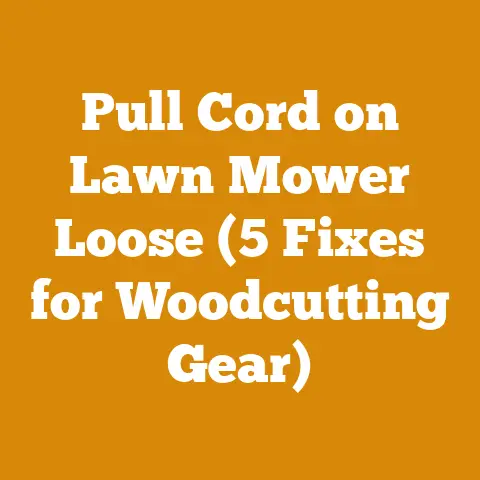Cut Boards with Chainsaw (5 Pro Tips for Pressure-Treated Wood)
Imagine this: you’re knee-deep in a backyard project, the kind that starts with “just a little something” and quickly morphs into a full-blown renovation. You’ve got your pressure-treated lumber, the sun’s beating down, and you’re ready to start cutting. But then it hits you – can you even use a chainsaw on this stuff? And if so, how do you do it safely and effectively? I’ve been there, trust me. It’s not quite the same as slicing through a seasoned oak, and there are some definite do’s and don’ts you need to know.
In this article, I’m going to share my top pro tips for cutting pressure-treated wood with a chainsaw. We’ll cover everything from choosing the right saw and blade to safety precautions and the best cutting techniques. My goal is to give you the knowledge and confidence to tackle your projects like a seasoned pro, whether you’re building a deck, a fence, or anything in between. So, grab your safety glasses, and let’s dive in!
Cutting Boards with a Chainsaw: 5 Pro Tips for Pressure-Treated Wood
Pressure-treated wood is a staple in outdoor construction, prized for its resistance to rot, decay, and insect infestation. But cutting it with a chainsaw requires a different approach than regular lumber. From choosing the right chainsaw and blade to understanding the specific challenges posed by treated wood, these tips will help you make clean, safe, and efficient cuts.
1. Selecting the Right Chainsaw and Blade
The first step in successfully cutting pressure-treated wood is selecting the right chainsaw and blade. Not all chainsaws are created equal, and the type you choose can significantly impact the quality of your cuts and your overall safety.
Chainsaw Power and Size
For most DIY projects involving pressure-treated wood, a mid-sized chainsaw with a 16- to 18-inch bar is ideal. These saws offer a good balance of power and maneuverability, making them suitable for a variety of cuts. Gas-powered chainsaws are generally more powerful than electric models, but cordless electric chainsaws have come a long way in recent years and can be a great option for smaller projects.
I’ve used both gas and electric chainsaws extensively, and I’ve found that electric models are particularly useful for indoor projects or situations where noise is a concern. They’re also easier to start and require less maintenance. However, for larger, more demanding jobs, a gas-powered chainsaw is still the way to go.
Chainsaw Blade Selection
The type of blade you use is just as important as the chainsaw itself. For pressure-treated wood, I recommend using a chain with a full chisel cutter. These chains have square-cornered teeth that are designed to cut aggressively and efficiently. They’re also more resistant to wear and tear, which is important when cutting treated wood, as the chemicals used in the treatment process can dull blades more quickly.
Another option is a chain with a semi-chisel cutter. These chains have rounded corners that are less aggressive than full chisel cutters, but they’re also more forgiving and easier to sharpen. They’re a good choice for beginners or for those who are cutting a lot of dirty or knotty wood.
Chainsaw Maintenance
Regardless of the type of chainsaw and blade you choose, it’s essential to keep them properly maintained. This includes regularly sharpening the chain, checking the bar oil level, and cleaning the air filter. A well-maintained chainsaw will cut more efficiently, last longer, and be safer to use.
I make it a habit to sharpen my chainsaw chain after every few hours of use. A sharp chain will cut through wood much more easily, reducing the risk of kickback and making the job less tiring. I also check the bar oil level before each use and clean the air filter regularly to ensure that the engine is running smoothly.
2. Understanding Pressure-Treated Wood
Before you start cutting, it’s important to understand what pressure-treated wood is and how it differs from regular lumber. This knowledge will help you make informed decisions about your cutting techniques and safety precautions.
What is Pressure-Treated Wood?
Pressure-treated wood is lumber that has been chemically treated to resist rot, decay, and insect infestation. The treatment process involves forcing chemicals deep into the wood fibers under high pressure. This creates a barrier that protects the wood from the elements and extends its lifespan.
The most common chemicals used in pressure-treated wood are alkaline copper quaternary (ACQ) and copper azole. These chemicals are effective at preventing decay and insect damage, but they can also be harmful if inhaled or ingested. That’s why it’s so important to take proper safety precautions when working with pressure-treated wood.
Types of Pressure-Treated Wood
There are different types of pressure-treated wood, each designed for specific applications. The most common types are:
- Ground Contact: This type of wood is treated to withstand direct contact with the ground. It’s commonly used for fence posts, decks, and other structures that are in contact with the soil.
- Above Ground: This type of wood is treated for use above ground, where it’s not in direct contact with the soil. It’s commonly used for deck railings, fence boards, and other non-ground contact applications.
- Marine Grade: This type of wood is treated to withstand constant exposure to water, making it ideal for docks, piers, and other marine applications.
Challenges of Cutting Pressure-Treated Wood
Cutting pressure-treated wood presents several challenges compared to cutting regular lumber:
- Chemical Exposure: The chemicals used in pressure-treated wood can be harmful if inhaled or ingested. It’s essential to wear a dust mask and gloves when cutting pressure-treated wood to protect yourself from exposure.
- Blade Dullness: The chemicals in pressure-treated wood can dull chainsaw blades more quickly than regular lumber. Be prepared to sharpen your blade more frequently when cutting treated wood.
- Splintering: Pressure-treated wood tends to splinter more easily than regular lumber, especially when cutting against the grain. Use sharp blades and proper cutting techniques to minimize splintering.
- Weight: Pressure-treated wood is often heavier than regular lumber, especially when it’s wet. Be careful when lifting and handling treated wood to avoid injuries.
3. Essential Safety Precautions
Safety should always be your top priority when working with a chainsaw, especially when cutting pressure-treated wood. Here are some essential safety precautions to follow:
Personal Protective Equipment (PPE)
- Safety Glasses: Always wear safety glasses to protect your eyes from flying debris.
- Dust Mask: Wear a dust mask to protect your lungs from inhaling sawdust and chemical particles.
- Gloves: Wear gloves to protect your hands from splinters and chemical exposure.
- Hearing Protection: Wear hearing protection to protect your ears from the loud noise of the chainsaw.
- Chainsaw Chaps: Wear chainsaw chaps to protect your legs from accidental cuts.
- Steel-Toed Boots: Wear steel-toed boots to protect your feet from falling objects and accidental cuts.
I can’t stress enough how important it is to wear the right PPE. I’ve seen too many accidents happen because people weren’t properly protected. Chainsaw chaps, in particular, are a lifesaver. They’re designed to stop the chain instantly if it comes into contact with your leg, preventing serious injuries.
Safe Cutting Practices
- Clear the Work Area: Before you start cutting, clear the work area of any obstacles, such as rocks, branches, or tools.
- Stable Footing: Make sure you have stable footing before you start cutting. Avoid cutting on uneven or slippery surfaces.
- Two-Handed Grip: Always use a two-handed grip on the chainsaw. This will give you more control and reduce the risk of kickback.
- Kickback Awareness: Be aware of the risk of kickback, which is when the chainsaw suddenly jumps back towards you. Avoid cutting with the tip of the bar, and always keep a firm grip on the saw.
- Proper Stance: Stand to the side of the chainsaw, not directly behind it. This will help you avoid being hit by the saw if it kicks back.
- Avoid Overreaching: Don’t overreach when cutting. Move your feet as needed to maintain a comfortable and stable position.
- Take Breaks: Take frequent breaks to avoid fatigue. Fatigue can lead to mistakes and increase the risk of accidents.
Handling and Disposal of Treated Wood
- Wash Your Hands: After handling pressure-treated wood, wash your hands thoroughly with soap and water.
- Dispose of Scraps Properly: Don’t burn pressure-treated wood scraps. The smoke can contain harmful chemicals. Dispose of them according to local regulations.
- Store Wood Properly: Store pressure-treated wood in a well-ventilated area away from children and pets.
4. Cutting Techniques for Pressure-Treated Wood
Using the right cutting techniques is essential for achieving clean, accurate cuts and minimizing the risk of accidents. Here are some techniques I’ve found to be particularly effective when working with pressure-treated wood:
Measuring and Marking
- Accurate Measurements: Use a tape measure and a pencil to accurately measure and mark your cuts. Double-check your measurements before cutting.
- Straight Lines: Use a straight edge, such as a level or a chalk line, to ensure that your cut lines are straight.
- Kerf Allowance: Remember to account for the kerf, which is the width of the chainsaw blade. Cut slightly outside of your marked line to allow for the kerf.
I always take my time when measuring and marking my cuts. A little extra effort at this stage can save you a lot of headaches later on. I also like to use a sharp pencil to make clear, visible lines.
Making the Cut
- Start Slowly: Start the cut slowly and gradually increase the pressure. This will help prevent the blade from jumping or kicking back.
- Follow the Line: Keep the chainsaw blade aligned with your marked line. Use a steady hand and avoid jerking the saw.
- Support the Wood: Support the wood on both sides of the cut to prevent it from sagging or splitting. Use sawhorses or other supports to keep the wood stable.
- Avoid Pinching: Avoid pinching the blade, which can cause the chainsaw to stall or kick back. If the blade starts to bind, stop cutting and reposition the wood.
- Complete the Cut: Once you’ve started the cut, continue until you’ve completely severed the wood. Don’t stop and start repeatedly, as this can create a jagged edge.
Cutting Different Shapes
- Straight Cuts: For straight cuts, use a straight edge as a guide. Clamp the straight edge to the wood and run the chainsaw along it.
- Curved Cuts: For curved cuts, use a jigsaw or a bandsaw. These tools are better suited for cutting curves than a chainsaw.
- Angle Cuts: For angle cuts, use a miter saw or a circular saw with an adjustable bevel. These tools will allow you to make accurate angle cuts.
I’ve found that using a straight edge is particularly helpful when making long, straight cuts. It ensures that the cut is perfectly straight and prevents the chainsaw from wandering off course.
Dealing with Knots
Knots can be challenging to cut through, especially with a chainsaw. Here are some tips for dealing with knots:
- Sharp Blade: Use a sharp blade to cut through knots more easily.
- Slow Speed: Cut through knots at a slow speed to prevent the blade from binding or kicking back.
- Multiple Passes: Make multiple passes through the knot, gradually deepening the cut with each pass.
- Avoid the Tip: Avoid cutting with the tip of the bar when cutting through knots, as this can increase the risk of kickback.
I’ve learned that patience is key when cutting through knots. Don’t try to force the chainsaw through the knot, as this can damage the saw or cause an accident.
5. Post-Cutting Considerations
Once you’ve finished cutting your pressure-treated wood, there are a few post-cutting considerations to keep in mind:
Sealing Cut Ends
When you cut pressure-treated wood, you expose the untreated core of the wood to the elements. This can make the wood more susceptible to rot and decay. To prevent this, it’s important to seal the cut ends with a wood preservative.
There are several types of wood preservatives available, including:
- Copper Naphthenate: This is a popular choice for sealing cut ends of pressure-treated wood. It’s effective at preventing rot and decay, and it’s easy to apply.
- Borate-Based Preservatives: These preservatives are also effective at preventing rot and decay, and they’re less toxic than some other options.
- Oil-Based Preservatives: These preservatives provide good protection against moisture and can help prevent the wood from cracking or splitting.
I prefer to use copper naphthenate for sealing cut ends of pressure-treated wood. It’s readily available at most hardware stores, and it’s relatively inexpensive. To apply it, simply brush it onto the cut ends of the wood, making sure to cover all exposed surfaces.
Fasteners
When fastening pressure-treated wood, it’s important to use fasteners that are compatible with the chemicals used in the treatment process. Using the wrong type of fasteners can lead to corrosion and premature failure of the fasteners.
The most common types of fasteners used with pressure-treated wood are:
- Hot-Dipped Galvanized: These fasteners are coated with a layer of zinc, which protects them from corrosion. They’re a good choice for general-purpose applications.
- Stainless Steel: These fasteners are highly resistant to corrosion and are ideal for use in marine environments or other harsh conditions.
- Copper: These fasteners are also resistant to corrosion and are often used in historical restoration projects.
I always use hot-dipped galvanized or stainless steel fasteners when working with pressure-treated wood. They’re a bit more expensive than regular fasteners, but they’re worth the investment in the long run.
Waste Disposal
As mentioned earlier, it’s important to dispose of pressure-treated wood scraps properly. Don’t burn them, as the smoke can contain harmful chemicals. Instead, dispose of them according to local regulations.
In many areas, pressure-treated wood can be disposed of in regular landfills. However, some areas have specific regulations for disposing of treated wood. Check with your local waste management authority to find out the proper disposal methods in your area.
Real-World Example: Building a Deck with Pressure-Treated Wood
Let’s break down a real-world example to illustrate these pro tips. I recently built a small deck using pressure-treated lumber, and here’s how I applied these techniques:
- Equipment Used: I used a gas-powered chainsaw with an 18-inch bar and a full chisel chain. I also had safety glasses, a dust mask, gloves, hearing protection, and chainsaw chaps.
- Wood Types: I used ground contact pressure-treated lumber for the posts and framing, and above ground pressure-treated lumber for the decking.
- Safety Considerations: I cleared the work area, wore all the necessary PPE, and followed safe cutting practices. I was particularly careful to avoid kickback and to support the wood properly.
- Cutting Techniques: I used a straight edge to make accurate cuts for the posts and framing. I also used a jigsaw to cut curves for the deck railing.
- Post-Cutting Considerations: I sealed the cut ends of the posts and framing with copper naphthenate. I used hot-dipped galvanized fasteners to attach the decking to the framing.
The project took me about a week to complete, and I’m very happy with the results. The deck is sturdy, safe, and should last for many years to come.
Conclusion
Cutting pressure-treated wood with a chainsaw can be a challenging but rewarding task. By following these pro tips, you can make clean, safe, and efficient cuts that will help you complete your projects with confidence. Remember to choose the right chainsaw and blade, understand the specific challenges posed by treated wood, take essential safety precautions, use proper cutting techniques, and consider post-cutting considerations.
I hope this article has been helpful. Now, get out there and start building! Just remember to stay safe, take your time, and enjoy the process. And if you ever have any questions, don’t hesitate to reach out to a professional. Happy woodworking!






